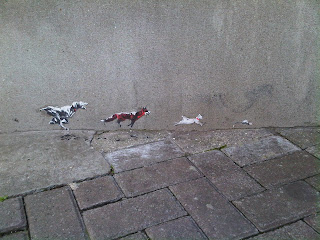This gives space to something much more creative and valuable for the society: Street Art. If you walk through Shoreditch, Brick Lane or Camden Town you'll find all the time new surprises, sometimes hidden so you can only notice it when you're very observant.
You'll find Street Art also in museum shops and design bookshops, but I still think Street Art is just best enjoyed where it belongs, in the street. There it is also exposed to the surrounding and the constant change, although it is definitely a shame, when you want to see a picture again and it's covered by something else.
A very interesting development is brands, which started to use Street Art or maybe Street Art, which started to use advertising? Sometimes it's not so easy to distinguish. It does not work for all brands of course, but where the brand has already a connection to the street and where the target group is the same, street art advertising works very well and is a wonderful bridge between art and commerce. Most of the pieces are unique and imbedded in the environment. The brand therefore can start a conversation with the people enjoying it and can very well represent its personality.
The examples I would like to show you now have all vanished already. Next time I see one, I'll post it...

